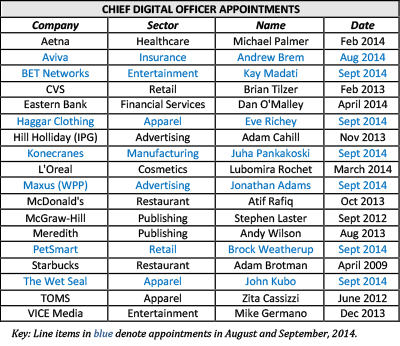
by Tim Bourgeois of ChiefDigitalOfficer.net
Over the past several weeks, we’ve witnessed no fewer than seven chief digital officer (“CDO”) appointments – some at major global brands – as companies continue to take dramatic action to digitally-enable their companies. And the hiring of a CDO, which is almost always a newly created position, is usually soon followed by major announcements about the definition, acceleration, or stabilization of a company’s digital strategy.
Because the CDO is a relatively new phenomenon – according to the CDO Club, there will be about 1,000 in place around the world by the end of 2014 – there aren’t case studies or data available yet to support or refute their existence. But, the concept has been embraced by and indeed espoused by blue-chip advisory groups like McKinsey, Gartner, and Forrester. And early adoption by high-profile B2C brands such as Starbucks and TOMS have paved the way for hundreds of companies to make the move during 2013 and 2014. This flurry of activity we’ve seen in recent months could prove to be the tipping point.
An Increasingly Crowded C-Suite
Does the executive team really need another member? Is there even room for one?
Time will tell. There certainly isn’t any shortage of new C-level titles that have cropped up in recent years: chief data officer, chief creative officer, chief revenue office, chief content office. The list goes on-and-on.
However, the case for the chief digital officer is compelling. For one, large companies that have already decided to install a CDO are aplenty, and include blue-chip brands, retailers, publishers, and advertising agencies around the world (see chart). Second, private equity investment has been pouring into start-ups whose mission is to clobber the Global 2500 by introducing disruptive, web-based solutions that undercut their products and services by being better, faster and cheaper. Think: Zappos in retailing, Dropbox for data storage, and Airbnb in hoteling. These companies have assaulted industry sectors previously dominated by behemoths with massive physical infrastructures, multi-billion dollar valuations, and sometimes hundreds of millions of dollars in cash reserves. As a result, these giants have come to understand – often begrudgingly – the need to have a digital advocate at the executive table to help mount defenses against the onslaught, and installing a CDO is a fast and clean way to do just that.

But Why A C-Level Spot?
The potential benefits associated with installing a CDO are considerable – both for practical and public relations purposes.
The move can be used as a marketing device. To wit: advertising agencies and publishing companies were quick to install CDOs, mainly to signal to the marketplace that they “get” digital – and are therefore able to sell digital-centric offerings in the marketplace.
The technique was soon picked up by brands, where the move signaled to employees, investors, and boards of directors that the executive team is focused on making digital a priority. For brands, the trickle-down effect is considerable, and includes placating boards that are demanding well-defined digital strategies, the financial markets that are asking for essentially the same thing (The Wet Seal stock price increased more than 4% after announcing it hired a CDO), and the move can also help to attract and retain talent (“We have a chief digital officer; digital is a big part of our plans; come here instead of joining a start-up”).
A CDO can help with partner and vendor relations, too. Alan Osetek, the President of Resolution, an Omnicom Media Group company – and one of the biggest buyers of search advertising in the world – thinks the CDO is a good idea. “I’m a big proponent of the chief digital officer role,” he says. “It’s not a requirement, of course, but it does communicate to firms like mine that digital is a priority, and that helps us to do our job more effectively as a brand’s digital marketing partner.”
A CDO Case Study in the Making?
In the midst of the August and September hiring spike, one CDO was prominently featured in the news: Atif Rafiq of McDonald’s. Recruited from Amazon in October of 2013, Rafiq is known to refer to himself as “employee #1 of McDigital”, and wasted little time in making his mark at the restaurant giant.
In June 2014, the company announced that it had opened an office in San Francisco – managed by Rafiq – and seeded it with a handful of employees who had companies like PayPal, Facebook, AOL, and Yahoo! on their resumes. Stopping short of calling it an “innovation lab”, the office clearly didn’t look like anything that had previously existed at the company.
And then, last month, alongside other monster retail brands like Nike, Walgreens, and Macy’s, was McDonald’s, listed as an Apple Pay partner. Would this have happened without Rafiq in place as CDO? Maybe. Was his installment as CDO instrumental in making this a reality? Absolutely. Rafiq was the contact that could speak on a peer level with Apple, deliver digital credibility, and communicate a compelling story about the changes he’d affected in just a short time at McDonald’s. Indeed, a Mashable story credits Rafiq with “getting on Tim Cook’s radar”.
It’s easy to envision senior executives at Haggar Clothing expecting a similar type of contribution from its new CDO. Haggar – which occupies the #1 spot of the men’s dress pant category in the U.S. – has been in business since 1926, but has been sluggish in adopting a digital strategy. In September, the company recruited the former Global Head of Digital Marketing from shoe company TOMS, which has had a CDO in place since 2012, to be its new CDO. TOMS most definitely “gets” digital business, and has a massive digital footprint to show for its efforts (for example, 2.1M Twitter followers versus Crocs’ 43K).
Far From Consensus About the CDO
As compelling as the case might be for a CDO in some circles, it’s not without detractors. Mayur Gupta, the Global Head of Marketing Technology and Innovation at Kimberly-Clark, thinks “it’s a step in the wrong direction if it’s a long term strategy for an organization – especially if the CDO role sits outside the world of the Chief Marketing Officer.”
And he’s not alone. During a CDO roundtable in Boston last year, Mike Troiano, the CMO of Actifio – a scorching-hot start-up from Boston which raised $100M in additional financing this year and is gaining major traction in a business historically dominated by EMC – remarked when asked about the viability of the CDO position: “It just doesn’t resonate with me – does that mean we had a need for a ‘Chief Analog Officer’ all these years, and no one realized it?”
It’s a sensible point-of-view. However, Actifio is a digitally-native company, and maybe the CDO role isn’t suitable for companies that have only been around for a few years. But it’s difficult to argue that many of the world’s largest companies have been slow – or negligent, even – in their response to digital transformation. And the installation of a chief digital officer – someone who has equivalent authority as the CMO, CIO, and maybe even CFO – seems to be an appropriate first step to addressing the problem. It’s certainly preferable to doing nothing, which companies like Best Buy and Radio Shack can tell you doesn’t work, either.
Tim Bourgeois is the founder of ChiefDigitalOfficer.net, a growing community of senior digital professionals whose responsibilities intersect strategy, marketing and technology. The Boston-based organization conducts original research, hosts events, and delivers advisory services related to digital strategy and transformation. You can follow him on Twitter at @ChiefDigOfficer, view his LinkedIn profile, or contact him directly at tbourgeois@chiefdigitalofficer.net.
